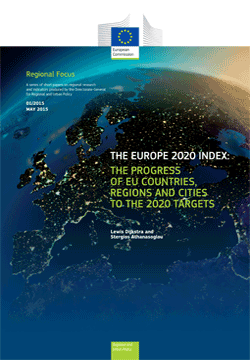The Europe 2020 Index: The progress Of EU Countries, Regions and Cities to the 2020 targets

Regional Focus
Date: 18 jun 2015
Period: 2014-2020
Theme: Energy, Environment, Rural development, Urban development, Research and innnovation, Sustainable development, Social inclusion, Jobs, Education and Training, Smart Specialisation, Inclusive growth
Languages: en
In 2015 the European Commission will review the Europe 2020 strategy. The review follows up on the recent public consultation and aims at improving and updating the Europe 2020 strategy, drawing lessons from the first four years of the strategy and ensuring it acts as an effective post-crisis strategy for growth and jobs in Europe.
EU Cohesion Policy will invest around a third of the EU budget in key areas in line with the Europe 2020 strategy for smart, sustainable and inclusive growth in 2014-20. To this end, a number of thematic objectives corresponding to the Europe 2020 priorities have been defined in the new legal framework. To maximise the impact of investment, Member States and regions need to concentrate EU funding on a limited number of these objectives in light of the specific territorial challenges they face and their development needs.
The urban and regional dimensions of Europe 2020 were first examined in the 7th Progress Report on economic, social and territorial cohesion in 2011 and subsequently in the 6th Cohesion Report in 2014. Two clear conclusions emerged from these reports and are confirmed by this Regional Focus. First, less developed regions are farthest removed from the 2020 targets. Second, cities in Cohesion countries are much closer to the 2020 targets than their towns, suburbs and rural areas are. Due to their strong performance, cities in Cohesion countries almost match the performance of cities in non-Cohesion countries. On average, the cities in non-Cohesion countries have an almost identical score as their towns, suburbs and rural areas, but in several countries the cities score below towns, suburbs and rural areas.
Overall, the crisis has made it harder to reach the employment and poverty reduction targets. The EU has made progress towards the research and development (R&D) target, but the trend is not strong enough to reach the target by 2020. Innovation remained highly concentrated in spatial terms and showed no signs of spreading to less developed regions. The EU has made progress towards both the renewable energy and greenhouse gas (GHG) emission reduction targets, although part of this is due to a drop in energy demand linked to the crisis. The progress towards the two education targets is encouraging, but a return to strong employment growth may stymie this progress.
This Regional Focus analyses where regions and cities stand vis-à-vis the Europe 2020 targets by extending and updating the analysis mentioned above. It uses three composite indicators to measure the progress of EU countries, regions and cities to the objectives of Europe 2020 strategy. The composite indicators at the national and the cities level are new and have not been presented before The regional composite indicator was already included in the 6th Cohesion Report, but it has been updated and the method has been refined.
